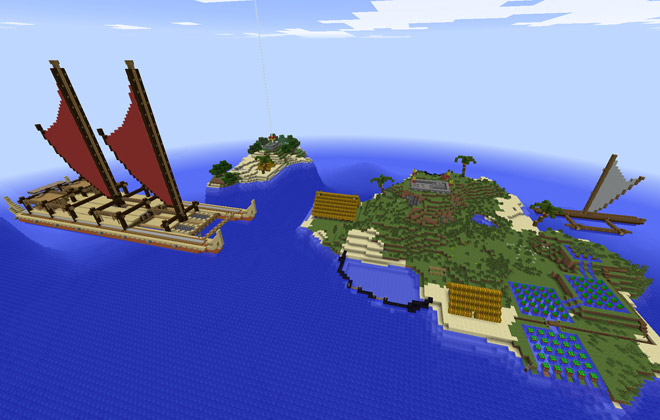Gabriel Yanagihara is taking children’s obsession with the video game "Minecraft" and turning it into a Hawaiian studies learning tool.
If you take a game students are already passionate about then hopefully they will learn something while playing it, said Yanagihara, a teacher in ‘Iolani School’s iDepartment, a technology learning center.
In "Minecraft," players dig holes, harvest wood from trees and build structures to create virtual worlds. The worlds range from very simple — a couple of homes on an island — to elaborate kingdoms with castles, bridges, lakes, coliseums or anything they can imagine. They can then populate these virtual landscapes with people, animals and imaginary creatures. Players must be mindful of the crops and farm animals they are raising to create a sustainable environment for the population or the world will fail.
"It (‘Minecraft’) has every biome possible," Yanagihara said. "It has jungle, desert, it has plateaus, pretty much any kind of environment."
Some players use the game to replicate settings from novels and movies or real cities around the world.
Following that idea, Yanagihara is offering a "‘Minecraft’ in Hawaii" workshop that focuses on recreating a Hawaiian island and the Hokule‘a with an emphasis on sustainability. The workshop reinforces principles being implemented in schools through a partnership between the state Department of Education and the Polynesian Voyaging Society.
Participants do research at home before the workshop and then work in teams to replicate in "Minecraft" the items they researched. One student may look into the types of homes Hawaiians lived in, while another student may study how the Hokule‘a was built. A third student would research the types of food Hawaiians grew and ate.
‘MINECRAFT’ WORKSHOPS
Gabriel Yanagihara teaches one-day "Minecraft" workshops for children in fifth to eighth grades at ‘Iolani School. Cost is $50 per class. No prior knowledge of the game is required.
» Sept. 20, 11 a.m. to 5 p.m.: "’Minecraft’ on Mars"
» Sept. 27, 11 a.m. to 5 p.m.: "’Minecraft’ in Hawaii"
» Oct. 11, 1 to 7 p.m.: "’Minecraft’ on Mars"
» Oct. 18, 1 to 7 p.m.: "’Minecraft’ in Hawaii"
» For more info or to register for "’Minecraft’ on Mars" workshops: http://bit.ly/1B2nXYZ Opens in a new tab
» For more info or to register for "’Minecraft’ in Hawaii" workshops: http://bit.ly/Z10pG9 Opens in a new tab |
The game is already equipped with sustainability functions such as not having trees and food if the player does not plant seeds and give them time to grow.
"Instead of just reading this is what the Hawaiians did and taking a test, they get to actually experience what it was like to have to build all these materials," Yanagihara said. When kids talk about building the Hokule‘a, "they expect they ordered it from Amazon and got it in the mail. … It’s really cool when the kids realize that they had to hike and pick up the wood … salt the fish and store it for months, and then go on the voyage." They understand how many people it took for the voyage to take place, Yanagihara said.
Currently the items in the "Minecraft" game are American rather than Hawaiian — oak instead of sandalwood, apples instead of breadfruit — but Yanagihara hopes to one day have an authentic Hawaiian "Minecraft" world. Until then, students post signs by their items such as "This is a lo‘i patch" or a sign that provides information the student discovered during research.
"They have to label their work so they can share it with anyone else in the world," Yanagihara said. "So once they’re done they’ll publish it online. … The idea is that anywhere that the Hokule‘a lands we can do the same thing there and send them this file and they can see that in Hawaii taro grows in the lo‘i and these are the taro plants. … They build (lo‘i) so that (water) streams downward. And then they leave notes (such as) ‘using gravity we can feed water to many fields or lo‘i.’"
Yanagihara also hopes that, with the global voyage of the Hokule‘a and Hikianalia taking place now, he will be able to get students from other countries involved in the project so one day his students can take a virtual trip to Tahiti or Pago Pago.
If students follow the same process with their cultural knowledge everywhere the Hokule‘a travels, Yanagihara said, "we may have the entire Pacific Ocean in one Minecraft world. Each community has their own island."
———
To host one of Yanagihara’s workshops at your school, contact him at gabrielyanagihara@gmail.com.






